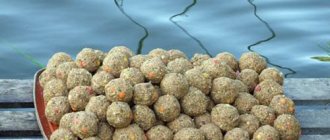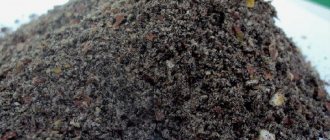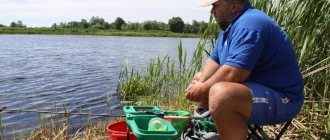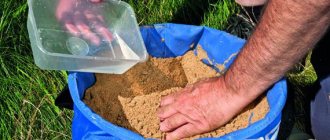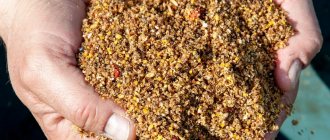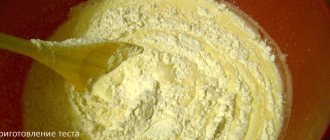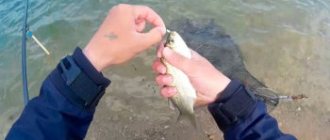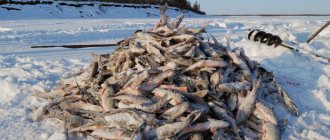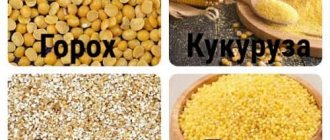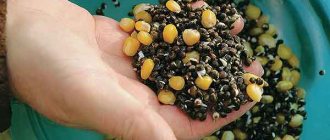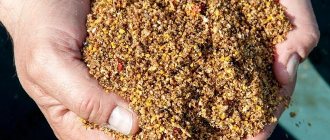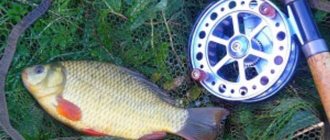Buy quality products at affordable prices in the best fishing online stores
. Give gifts to yourself and your loved ones!
we are in social networks
— subscribe to us on Facebook, Youtube, VKontakte and Instagram. Stay up to date with the latest site news.
Crucian carp is considered a gourmet who is not always easy to please. If in closed chamber reservoirs he happily eats macadamia and crackers, then on medium and small rivers he requires more refined dishes with the addition of all kinds of attractants and dips. In this article we will get acquainted with the best baits for catching crucian carp on a feeder. Let's find out which components are basic, which flavorings and attractants work best for crucian carp.
Bait recipe for crucian carp on feeder No. 1
To prepare bait according to this recipe we will need the following components:
- Millet cereal – 2 cups
- Ground flour or roasted sunflower seeds – 2 cups
- Chocolate bar
- Breadcrumbs – 1 kg
- Anise -10 drops
First, cook the millet according to the standard method. For 1 glass of cereal, 3 glasses of water are required. Add millet to boiling water and cook for 8-10 minutes. After this, drain the remaining water and cover with a lid and leave the porridge to finish.
After 20-30 minutes, pour the flour and some of the crackers into the porridge, and add anise drops. That's not all. We need melted chocolate. Any tile will do. Take the tile and melt it in a small saucepan over low heat. Pour the resulting liquid mass into the prepared porridge and mix well. We should get a fragrant and quite thick brown bait with a characteristic chocolate taste.
If we fish on a river with a strong or slow current, then we don’t need to add anything to the bait. This composition works great in the warm season. Such bait does not lose its original aroma and taste with a clock. Moreover, chocolate is a kind of preservative and protects the mixture from souring. Try to prepare this version of the mixture, and you will get bites not only from crucian carp, but also from bream and carp.
When fishing in slow-flowing waters, add another part of the crackers to get a more crumbly mixture. This porridge is designed for fishing with one feeder in the warm season for 5-6 hours. If there is any leftover, you can save it for another fishing session by placing it in the freezer.
What important elements does bait consist of?
So that you can experiment and come up with your own recipes for fertilizers that work for crucian carp, we will tell you what they should consist of.
Each of them has important elements in the base that contribute. Having understood the principles of creating a recipe, you can easily bring your ideas to life, ensuring a good bite. 7 main components:
- Dusty. A cloud of turbidity and dust perfectly attracts white fish. To create it, add semolina and milk powder.
- Large faction. To prevent large fish from leaving the area, large particles are added to the bait. Their role is played by: various cereals, corn, peas. If they are not kept, the crucian carp will quickly swim away, since it will swim towards the smell and the dregs will not find anything to profit from.
- Connecting elements. Breadcrumbs, wafer crumbs, biscuit crumbs, flour. As the name suggests, they are used to bind all the ingredients together to form a single mass. Depending on their quantity, the final mass will be airy (for the feeder) or more sticky (for balls).
- Weights. The main task is to deliver the food to the bottom, creating a flat spot, the so-called table. All the fish gather in this spot. If the mixture is too airy, it will dissipate before reaching the bottom, and if there is a current, it will be carried far from the fishing spot. Use: soil and clay. The first option is for standing reservoirs. The second, depending on the quantity, is universal, and it helps perfectly with fast flows.
- Flavors. With the help of attractants you can add absolutely any desired flavor: garlic, honey, worm, plum, caramel, chocolate. The smell is great for attracting any fish. For this purpose, either purchased syrups, molasses or natural ingredients are used, for example honey diluted in warm water.
- Animal components. They are especially relevant in spring and autumn, when crucian carp switches to protein, high-calorie foods. Chopped worms, maggots and crushed bloodworms are excellent choices.
- Floating particles. Few people know, but there is also such a secret. Often used for float fishing. After hitting the bottom, ingredients with positive buoyancy float up, amazingly attracting the attention of fish. In this role they use: husks from hemp seeds and grains (only whole). They practically do not absorb moisture, which means they will definitely float.
The smell begins to work first, spreading the aroma far across the pond. After this, food of different fractions comes into play, forcing you to stay at the point. Learn to maintain balance: if a silverfish gets full, it will immediately swim away. The task is to feed it, preferably with food that does not contain nutrition. To speed up digestion, supplements are used (for example, ground peanuts).
Recipe No. 2
To prepare this mixture we need the following ingredients:
- Breadcrumbs – 1 kg
- Ground seeds - 2 cups
- Oatmeal cookies – 0.5 kg
- Dry Hercules – 300 gr.
- Boiled barley – 0.5 kg
- Sunflower oil, unrefined – 2 tbsp. spoons
First, cook the pearl barley until fully cooked. To make 500 grams of pearl barley porridge, we need a little less than a glass of dry cereal and 2.5 glasses of water. After preparing the porridge, add water, close the pan with a lid and let the porridge brew for 20 minutes. After this, add some of the dry ingredients.
Grind the seeds in a meat grinder. During the process, add oil so as not to damage the knives and further flavor the bait.
Grind all ingredients well and place in the refrigerator. While fishing, add the remaining dry ingredients. If we fish in medium and slow currents, then we make the bait more crumbly. When fishing in a strong current, add a little soil or clay to the mixture, which will glue the bait together.
If we fish with a picker or light feeder at a distance of up to 30 meters, then we can also feed with a slingshot. Crucian carp is a schooling fish, which is not always easy to keep at one point. Therefore, it is better to feed several points. Moreover, some anglers use several different baits, determining which one will work best that day.
General requirements for bait
It is very important to ensure that the vast majority of the components of bait for crucian carp are finely ground. Thanks to this, the fish will not get satiated so quickly and will live longer within the fishing radius.
The mistake is overfeeding. There is no need to throw too much bait.
If the reservoir contains a large number of bleak, roach, and silver bream, then you need to exclude egg powder from the bait, which will attract small fish.
The color of the bait should not differ from the bottom of the reservoir. Light colors on a dark bottom will scare the crucian carp.
The bait should be viscous enough so as not to fly apart when casting.
It is advisable to take water from a well or the same reservoir where fishing will take place.
Recipe No. 3
Another good bait for crucian carp fishing is suitable for feeder and float fishing. To prepare this bait we need the following components:
- Boiled peas – 500 gr.
- Makuha – 500 gr.
- Bran – 500 gr.
- Biscuit cookies – 500 gr
- Store-bought bait for crucian carp with chocolate scent – 1 kg
- Nesquik cocoa - ½ cup
- 2 teaspoons cinnamon
First, cook the half-cooked peas. Pour 2 glasses and pour 6 glasses of water into the pan. Cook for 30-40 minutes until soft grains form. After cooking, let the porridge brew and transfer it to a bag or pouch.
Pour all the dry ingredients into one container and mix well to form a loose mixture. When fishing, mix it with peas, adjusting the viscosity depending on the strength of the current. If necessary, add soil or clay. There is another very effective method - add honey. If you have such a product of medium viscosity, then add 6-7 tablespoons to the bait. The smell of honey attracts crucian carp very well, noticeably sweetening the porridge.
Varieties and methods of preparation
Flour
Cornmeal bait for crucian carp.
Compound:
- Can of whole corn;
- Vanilla extract.
Preparation
Cans of corn usually contain water. To prepare, you need to drain the water, leaving only five percent in the jar. Pour the vanilla extract into the jar until the mixture turns yellowish brown. Shake the jar and let the corn absorb the vanilla.
Dough for crucian carp:
- 1 cup flour;
- 1 cup corn flour;
- vanilla extract;
- 1 glass of water.
Preparation:
This is one of the best bait recipes for almost any white fish. To make this bait, add flour and cornmeal to a large bowl. Pour vanilla extract into one cup of water in a saucepan and bring it to a boil. Add a mixture of two types of flour to boiling water. Once the water is absorbed, remove the pan from the heat. Once the dough mixture has cooled, you need to knead and knead it until it is firm enough to stay on the hook.
Quick DIY recipe
To prepare you will need:
- 1 cup flour;
- Wheat flakes (crumbly);
- Garlic;
- Salt;
- Water.
Mix all the ingredients together and add them to the water. From the resulting mixture you can form balls that will be used as bait.
Strawberry bait
To prepare take:
- 2 cups oatmeal;
- 75 gr. strawberry jelly;
- Water.
Mix all ingredients thoroughly. Roll out into a uniform layer and let rest for two to three days.
By their nature, bait can be different: animal, plant (natural) and artificial bait, made in factories or manually.
Earthworms
The natural diet of crucian carp is quite varied. He is an omnivore. Recently, such bait as a worm has become undeservedly forgotten by fishermen who love modern baits, for example, boilies. And completely in vain. Indeed, according to many characteristics, an ordinary worm is nutritious and preferable for these fish. You can use manure or rain. This type of bait is especially effective for bottom fishing. The fisherman's secret: in order for the worm to live on the hook for a long time, the puncture should be as small as possible, it is better to plant it in a bunch or through the back, and so that it does not slip off the hook, it can be secured with maggots.
Larvae
They are also the natural food of crucian carp, as they naturally enter the body of water. The most commonly used were maggots and bloodworms, especially before the advent of artificial baits on the domestic market. The appearance of these baits does not cause suspicion among cautious fish. The only drawback is the ability to attract change. These types of larvae can be used as separate baits, putting several pieces on a hook. They can also be used as a complement to other baits. They are best suited for bottom fishing. They can also be added to various cereals, preferably whole and alive.
Vegetable attachments
None of the fishermen can tell you how to make the best bait for crucian carp yourself. But many people prefer to use old-fashioned, proven baits: corn and peas, pearl barley and wheat cereals, semolina, bread, dough. All these components are traditionally used as bait for crucian carp. The main thing is that each variety must be cooked correctly, then the fish will certainly try it. The main thing is to remember seasonal preferences; plant baits perform well mainly in the summer.
Corn
It is often used for fishing in the form of canned food. Sweet, soft (but structural enough to fit well on hooks) grains attract crucian carp with both taste and smell. It does not even require the introduction of additional flavors, as is the case, for example, with dough or bread.
Therefore, when asked which bait to fish with, many choose this option. But you can add flavoring with dye (natural food, in no case chemical), if you so desire. They are usually added directly to a can of canned food that has just been opened, or you can make the whole thing at home in advance of your fishing trip.
Some people prepare boiled corn themselves. But here, too, the choice is influenced by the main drawback - the relatively long preparation time. That's why many people still choose the canned version.
Peas
Well-steamed peas are an excellent treat for crucian carp. The main thing is to cook correctly, but there are some secrets here.
- Soak in water at room temperature for up to 8 hours.
- Cook in a saucepan for at least an hour (if you have a pressure cooker - 15-25 minutes).
- Air drying takes at least half an hour.
After this, the pea grains can be flavored and put on the hook. But you can do without attractants. The smell of peas spreads very well in the water, and crucian carp have a heightened sense of smell.
Dough
This bait is most in demand when fishing with the so-called pacifier. What is needed here is a viscous, attractive consistency. Dough is the best option. It can be prepared from one or more types of cereals and flour. For example, mastyrka or mamalyga (using flour and semolina). Every more or less experienced fisherman has his own recipe, and sometimes more than one. When preparing it yourself, you can easily achieve the desired consistency and desired aromatic properties, based on the time of year or the body of water where fishing takes place.
Wheat, pearl barley
Cereals steamed in a thermos, flavored with anise, are the best bait, according to some fishermen. Moreover, these dishes are natural for crucian carp and are actively included in the diet (they end up in waterways naturally, where they eat them). The preparation method is simple: pour a glass of cereal into a large thermos, pour boiling water over half and close tightly, leave overnight . The grain will steam and become soft, but the outer shell will remain more or less hard, making it easy to hang several on a hook.
Bread
This is a very affordable bait that holds the hook well. Wheat or rye - it attracts crucian carp with its characteristic aroma and taste. Experienced anglers say these baits work best when the fish start to rise and swim close to the surface. Bread is also used in heavily clogged reservoirs where the fish density is quite high. Some anglers use a variation called a "floating crust" where the crust is placed on a weighted hook to attract fish.
Boyle
This invention came from abroad and immediately appealed to many Russian fishermen. The boilies are quite large, which allows you to avoid bites from small individuals and wait for a serious, large trophy. Many different ingredients are used to make boilies. Among the most common are corn and soy flour, semolina, eggs, and various flavorings. You can buy them at a fish store, or you can make them with your own hands, both floating and sinking ones, depending on their components. Sizes are selected depending on the size of the fish.
It is necessary to carefully prepare for catching crucian carp in order to be sure that it will be caught on the hook of the fishing rod. As you know, before you start fishing, you need to choose a place and throw some bait into the water, which was prepared in advance at home.
You can buy carp bait in a store or make it yourself. There are a lot of recipes for this.
The basis
It must have some nutritional, taste and aroma characteristics so that the fish can smell it from afar and want to eat it.
The following components are used for preparation:
- Breadcrumbs. They can be prepared by frying wheat or rye bread and grinding it in a meat grinder. You can add a little ground biscuits (for example, “baked milk” or vanilla). However, we must remember that the sweet component glues the bait, so it should be added if fishing will take place on the river.
- Makukha (waste after pressing sunflower seeds). It should make up twenty percent of the entire base. Can be used both as a separate bait and as a component. Also very effective on rivers.
- Roasted sunflower seeds, ground. They should keep for one to two weeks. Can be used instead of makukha.
- Corn grits. Can be used in any form (boiled, raw, fried). The main thing is that it should not be more than forty percent of the amount of crackers.
- Flour (oat or barley). There should be no more than one third of the main element.
- Various baking powders (if fishing is carried out in still water). It can be bran, waffles. The ratio of baking powder to the total volume of the base should not exceed twenty to thirty percent.
Compound
To understand how to make bait more effective, you need to keep in mind that it should have a pleasant and attractive taste, but not saturate the fish.
This can be well-cooked (canned) peas, boiled barley, canned corn, worms, maggots, boiled millet, bloodworms.
The optimal ratio of feed to the total volume of bait is usually no more than forty percent.
If in autumn or spring fishing will take place in a small pond in cool water, then when preparing fish baits, plant products may not be added at all or it is recommended to reduce them.
Add-ons
Recipes for universal fish bait prepared by yourself must include additives, which are divided into:
- vegetable (roasted ground peanuts or sunflower seeds, milk powder);
- flavorings (instant or natural ground coffee, salt, fish feed, various attractants);
- binding components (finely ground various flours - corn, oatmeal and wheat, starch).
Flavors
Both store-bought and natural herbal ingredients can be used as aromatic additives.
Currently, there is a huge selection of different scents in stores. They are sold both in the form of drops and as a spray.
When using a sprinkler, you need to spray the feeder and bait before each cast, this will be enough.
If you use drops, you must keep in mind that the smell of the attractant should not interrupt the main one. This may simply scare away the fish. In winter it is better not to use it at all. The smell dissipates poorly in cold water and concentrates around the bait, and disperses the fish.
For each body of water it is necessary to select its own fragrance scent.
Among the natural ones, garlic, finely chopped dill, and anise perform very well when catching crucian carp. You can also add vanilla, which can be purchased in liquid form in fishing stores and culinary stores.
Various vegetable oils are also widely used: sunflower (refined and unrefined), olive, flaxseed and others.
Recipe No. 4
The following catchy recipe for fishing crucian carp includes the following components:
- Loaf of fresh white bread
- Oatmeal – ½ cup
- Bran – 2 cups
- Ground roasted sunflower seeds – 2 cups
- Vanillin packet
- Universal feeder bait – 1kg
- Coriander – 2 teaspoons
- Peel of 1 orange
Grind the loaf and peel in a meat grinder along with the seeds. We get a viscous mass, which we mix with bran and store-bought bait. While kneading, add oatmeal, vanillin and coriander. As a result, we will get a mixture that will have a great smell. It is best suited for fishing on rivers with fast and slow currents.
When fishing for crucian carp, it is better to use two feeders. We throw one at a long distance, and the second at a short distance. This way we will increase the chances of catching and find out which places this fish prefers to visit at different times.
Bait menu for crucian carp
The basis of the menu for crucian carp at this time is worms, shells and bloodworms. In warm weather, you should look for it in the shallows, but in cold weather, crucian carp can only be caught at a depth of about 3-4 m.
Since crucian carp bite well during the autumn rain, apparently anticipating the arrival of cold weather, bait plays a very important role at this time. Compared to the summer period, there may not be so much of it, but ingredients of animal origin should become an integral component. You should stop using summer complementary foods; they are ineffective in cold water conditions. This composition has proven itself to be quite good: a handful of steamed cake, chopped worms or maggots (you can do both at the same time) plus two shovels of earth taken from the shore of a reservoir.
Recipe No. 5
To prepare this bait we need the following components:
- Corn flour – 2 cups
- Sugar – 4 tablespoons
- Pea flour – 1 cup
- Semolina – 1 cup
- Bait for catching crucian carp on the river – 2 kg
- Ground macadamia – 0.5 kg
First, take a pan and pour 1 liter of water into it. Pour sugar into it. As soon as the water boils, add corn grits to it, followed by peas. Stir the grains vigorously to prevent burning. Cook for approximately 15 minutes. At the end, add semolina and wait 5 minutes. After this, remove from the heat and carefully wrap the porridge and leave for half an hour. Next, stir the mixture and send it to cool in the refrigerator.
When fishing, we pass the flour and bait through a sieve and add porridge to them. If we need a more crumbly bait, then we add more crackers to the composition. If, on the contrary, a more viscous mass is required, then add clay to the composition. We watch how the bait is washed out and the feeders are washed out. If, after reeling out the gear, we see an empty feeder in front of us, then the density of the bait is normal. If there is porridge left in the feeder, then add more bulk elements to it.
What can you fish with?
In general, for catching crucian carp in September, all the same gear that was used during summer fishing will be suitable, except that you can experiment with individual parts of the fishing rod (for example, choose a longer or, conversely, a short rod).
Find out how to catch crucian carp in June using a float rod.
As a rule, the list of suitable gear for autumn crucian carp fishing can include the following products:
- fly fishing rod , which is perfect for casting from the shore (the length of the form can be up to 11 m);
- match rod for long float casts;
- Bolognese fishing rod (great for medium casting and line fishing);
- plug-in tackle (characterized by a targeted type of supply of complementary foods and considerable cost, which not everyone can afford);
- ordinary donka and elastic band , which are often used by novice fishermen;
- a bottom fishing rod of the “crocodile” type (this is the first stage on the way to the feeder, because usually after using such gear, fishermen switch to a classic English fishing rod);
- the feeder is the leader among bottom gear, since fishing with its use attracts an increasing number of fishermen (main advantages: ease of use, affordable cost, elegance).
Which type of tackle to choose depends on the personal preferences of the fisherman and his capabilities, but the simplest and most popular option is deservedly considered an ordinary float fishing rod with a certain set of accompanying parts.
Did you know? Today, both silver and golden carp are found in reservoirs, although few people know that the latter were bred artificially. The first representatives of “goldfish” of various breeds appeared in China more than a thousand years ago.
Recipe No. 6
When fishing on rivers and in reservoirs with currents, bait consisting of the following components works very well:
- Steamed wheat grains – 1 kg
- Honey – 100 grams
- Oats – 1 kg
- Ground macadamia – 0.5 kg
- Universal feeder bait – 1 kg
To prepare this bait, first cook the wheat. Soak 2 cups of grain in water for 12 hours. Then cook until the grains open for 1 hour. Drain the water, cover the pan with a lid and let it brew. After this, add the remaining ingredients. As a result, we will get a very high-calorie bait that has a very rich and rich aroma. It can be used when fishing on rivers and lakes.
Feeding should be done pointwise, forming a bait spot measuring one meter by one meter. When fishing in the current, a strip several meters long will be created. The crucian carp will swim to such an elongated table. To keep them, food must be delivered accurately. To do this, be sure to fix the fishing line in a clip and throw it at a landmark chosen on the shore.
Habitat of crucian carp
The favorite habitats and other features of the silver and golden varieties of crucian carp are the same, so further they will be considered together. The only difference is that silver individuals are much more common in the wild than their golden relatives.
Initially, the only place where this fish lived was the Amur River, however, starting from the middle of the 20th century, through the method of artificial resettlement, it was distributed throughout a large number of European and Siberian rivers and fresh water reservoirs.
Today, this process has not yet ended, and crucian carp is gradually developing new habitats - Indian reservoirs and North American rivers. Initially, it was the golden crucian carp that was considered the traditional variety, but today’s trends are such that their number is rapidly decreasing, and they are gradually being replaced by the silver species.
The most preferred habitat is reservoirs with no current, calm water and a soft muddy bottom. There are all conditions for favorable living conditions for crucian carp: the water is well warmed by the sun's rays, and the thickets are an ideal place for rest and shelter.
Since the amount of oxygen contained in the water space is absolutely not important for this fish, it can also live and thrive in very wetlands. Even severe freezing of water in winter does not frighten them, since the fish still tries to stick to the space near the bottom surface.
The lifestyle and habitat of the golden and silver species, as already mentioned, are virtually the same, but there is much less chance of encountering the golden species in running water.
Recipe No. 7
To prepare this bait we need a small amount of components:
- Pearl barley – 1 cup
- Bait for crucian carp with the smell of garlic – 1 kg
- Millet – 2 cups
- Breadcrumbs – 1 kg
- Molasses with vanilla flavor – 0.5 l
- Store-bought hemp powder – 200 grams
First, cook the pearl barley in the same way as in previous recipes. 10 minutes before the end of cooking, add millet. After the water has boiled away, leave the porridge to sit, tightly covering the pan with a lid. Then add crackers, groundbait and powder, and mix everything well.
When fishing, add molasses and mix well again. As a result, we will get a high-calorie bait for the feeder for crucian carp. For effective fishing, we feed with 10 medium feeders. Then we make casts every 10 minutes.
The meaning of using bait
Fattening crucian carp actively moves around the reservoir, approaches the very shore and is excellently caught using float and bottom gear. And it may seem that he does not need affection.
However, it has long been noticed that bait works flawlessly on crucian carp: it “collects” it in one place from a very large area, and - most importantly - detains it there. And with regular use it can become addictive for a long time. On top of everything else, properly prepared bait often “provokes” the fish, that is, the notorious “bite activator” is triggered.
Therefore, fishing with bait will always be more successful than without it. If, of course, the fisherman takes into account some of the nuances associated with the habits of the fish and prepares the bait correctly.
Is it necessary to add flavorings to bait?
A fact confirmed in practice is that crucian carp go much better on bait to which flavorings have been added: and they should not be synthetic, but of natural origin. The only effective artificial ingredient that can be used is kerosene.
It is also important not to add flavorings to the bait mixture - it is better if there is less of it and the aroma becomes weak than to scare off potential prey with a too strong and unfamiliar smell.
Of the natural varieties, it is recommended to use:
- Roots of plants that grow in areas with plenty of water, such as reeds, cattails, or water lilies.
- Cocoa in powder form.
- Vanillin crystals.
- Grated garlic.
- Anise extract and seeds.
- Crushed dill seed.
There are also the following tips for using and preparing flavorings:
- It is best to prepare several mixtures with different aromatic effects and experimentally try them directly while fishing to identify the most effective option.
- The roots of most plants, such as anise, reed, cattail and others, not only have a strong aromatic effect, but are also well stored in dried form for a very long time. You can make blanks by cutting off a small amount from them before each fishing trip.
Fishing options
During the development of carp fishing, different methods of catching this fish have appeared, which are effective in certain bodies of water, at different distances, at different depths.
Float
The most popular type of fishing. Use float tackle when fishing for carp immediately in the spring, when the reservoir clears up after the ice melts and warms up. But the most effective time to fish with a float is in July. This fishing ends in October with the arrival of frost.
Advantages of float tackle:
- You can effectively catch it when carp spawning ends and the fish are near the shore;
- effective fishing when the carp rises to the surface in the heat to breathe air;
- you can fish in different bodies of water that contain silt, and the spring with the bottom simply falls into the ground.
The float rod is selected and equipped in different ways, this will depend on the size of the carp.
The following types of fishing rods are used:
- plug;
- match;
- max.
To catch carp weighing up to 3 kg, you can choose any of these rods.
Makushatnik
The main element of the equipment is a briquette of compressed corn flour, a product obtained by squeezing sunflower oil.
This topping has a strong, slightly greasy aroma. The “makushatnik” equipment is a lead plate, fishing line and 4 hooks on a leash.
Makushatnik
Pacifier
There are a large number of varieties of pacifiers. The fisherman decides which nipple to use. In this case, the spring contains the bait along with the hooks. It is necessary to use viscous bait. Next, make sure that the equipment falls with the bait down and the hooks towards the top - otherwise the fish will not bite.
The leash is made from a cord approximately 5 cm in size. If you assemble the tackle correctly, then fishing with a nipple always shows good results.
Fishing pacifier
Spring
With this fishing method, the bait can be porridge, dough or other plant food. The equipment in this case is very important - it consists of a spring, which is made of wire with a cross-section of approximately 2 mm.
The spring has the shape of a donut, with a cross-section of about 5 cm. Six leashes are tied to it. The bait is in a spring. At the same time, it must be as viscous as possible in order to completely fill the spring and then stick it on top. 2 hooks are installed in the center of the bait, and the remaining ones are inserted into the porridge located outside.
Spring for catching tench, crucian carp, carp, chub
Feeder fishing
The feeder must include all the main elements, starting from the fishing rod and ending with the attachment of the feeder. The spread of this method of fishing in our country is hampered by the ignorance of many beginners about how to fish with a feeder.
There is another important reason - not all fishermen can purchase a feeder fishing rod and the necessary gear for it, since this is quite an expensive pleasure. When carp fishing on a feeder, special feeders are used.
Feeder fishing involves using a feeder to create a feeding spot at the bottom of the reservoir.
Carp fishing
This is amateur or sport carp fishing, when the basic rule is observed - “catch, release”. The carp fisherman does not take the fish with him, he catches it, takes a photo, treats the wound, and releases it back into the pond.
